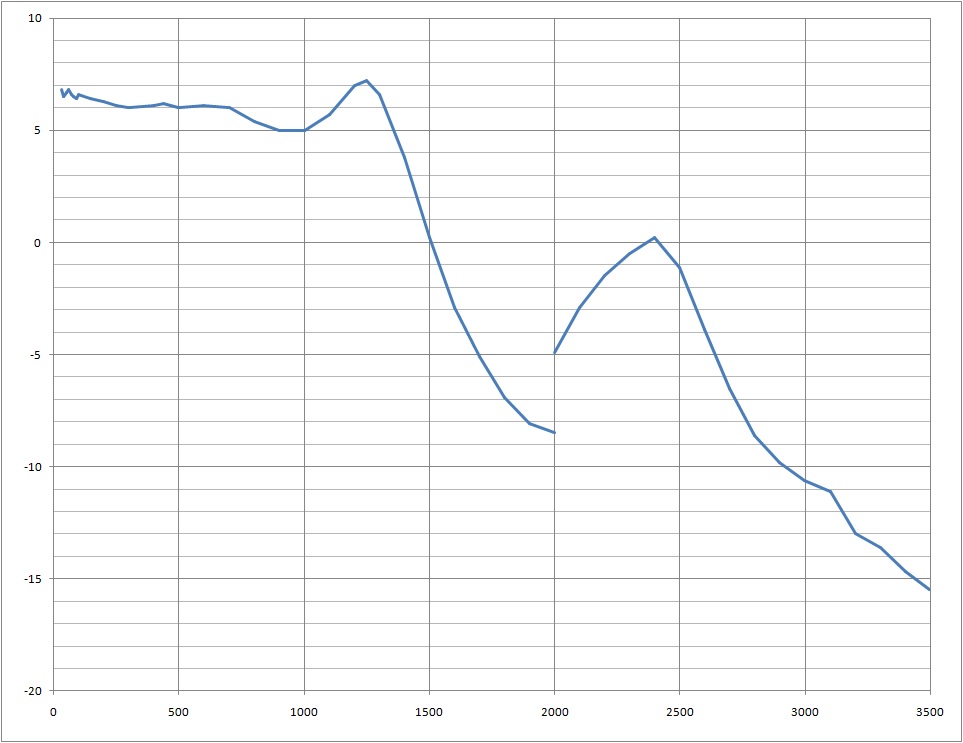Difference between revisions of "LimeSDR Mini Output Power Levels"
(Created page with "The output power of the Lime Mini varies significantly across the bandwidth and does not vary linearly with adjustments to the "Lime Gain" on the Portsdown. ===Variation with...") |
|||
| Line 6: | Line 6: | ||
[[File:LimeSDR Mini Output.jpg|963px]] | [[File:LimeSDR Mini Output.jpg|963px]] | ||
| + | |||
| + | The discontinuity at 2 GHz is where the output circuitry is switched between low band and high band. | ||
| + | |||
| + | ===Variation with Lime Gain=== | ||
| + | |||
| + | There are 3 modes that respond differently to the Lime Gain parameter: Carrier, DATV with 2x up-sampling and DATV with 4x up-sampling. | ||
| + | |||
| + | For Portsdown software version 201812290, the following Lime Gain settings are most consistent (plus or minus 1 dB) across the modes: | ||
| + | |||
| + | {| class="wikitable" | ||
| + | |- | ||
| + | ! Lime Gain !! 437 MHz Power | ||
| + | |- | ||
| + | | 98 || 11.8 dBm | ||
| + | |- | ||
| + | | 96 || 10.0 dBm | ||
| + | |- | ||
| + | | 92 || 6.3 dBm | ||
| + | |- | ||
| + | | 88 || 4.4 dBm | ||
| + | |- | ||
| + | | 84 || 0.8 dBm | ||
| + | |- | ||
| + | | 82 || -0.1 dBm | ||
| + | |- | ||
| + | | 81 || -1.1 dBm | ||
| + | |- | ||
| + | | 80 || -2.1 dBm | ||
| + | |- | ||
| + | | 79 || -3.0 dBm | ||
| + | |- | ||
| + | | 77 || -4.0 dBm | ||
| + | |- | ||
| + | | 75 || -6.0 dBm | ||
| + | |- | ||
| + | | 72 || -8.0 dBm | ||
| + | |} | ||
| + | |||
| + | The use of intermediate Lime Gain values is not recommended as they give inconsistent results. For example at Lime Gain 87, carrier mode generates 4 dB more power than DATV. | ||
| + | |||
| + | For operation at other frequencies, the expected output power is reduced in line with the graph above. | ||
Revision as of 17:41, 12 January 2019
The output power of the Lime Mini varies significantly across the bandwidth and does not vary linearly with adjustments to the "Lime Gain" on the Portsdown.
Variation with Frequency
The measurements below were made with a LimeSDR Mini using a Portsdown transmitter (version 201812290) at Lime Gain = 88.
The discontinuity at 2 GHz is where the output circuitry is switched between low band and high band.
Variation with Lime Gain
There are 3 modes that respond differently to the Lime Gain parameter: Carrier, DATV with 2x up-sampling and DATV with 4x up-sampling.
For Portsdown software version 201812290, the following Lime Gain settings are most consistent (plus or minus 1 dB) across the modes:
| Lime Gain | 437 MHz Power |
|---|---|
| 98 | 11.8 dBm |
| 96 | 10.0 dBm |
| 92 | 6.3 dBm |
| 88 | 4.4 dBm |
| 84 | 0.8 dBm |
| 82 | -0.1 dBm |
| 81 | -1.1 dBm |
| 80 | -2.1 dBm |
| 79 | -3.0 dBm |
| 77 | -4.0 dBm |
| 75 | -6.0 dBm |
| 72 | -8.0 dBm |
The use of intermediate Lime Gain values is not recommended as they give inconsistent results. For example at Lime Gain 87, carrier mode generates 4 dB more power than DATV.
For operation at other frequencies, the expected output power is reduced in line with the graph above.
